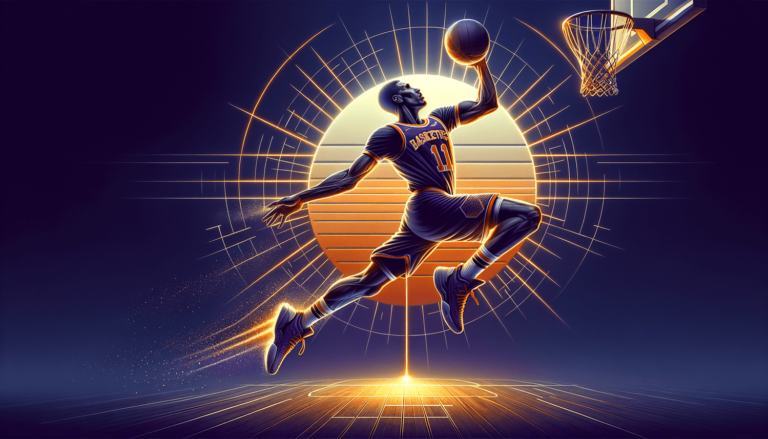
How to Increase Your Basketball Stamina and Endurance?
Written by: Basketball Universe
Last updated:

In the high-intensity, fast-paced world of basketball, stamina and endurance are critical components for players seeking to up their game. If you’re looking to transform yourself into a relentless force on the court, you’ve come to the right place! This fun, yet professional guide will explore evidence-based techniques that can help you develop ironclad stamina and unwavering endurance. From tailored workouts to lifestyle adjustments, we’ve got you covered. So, lace up, grab a ball, and let’s elevate both your fitness and performance levels to new heights!
How to Increase Your Basketball Stamina and Endurance?
To increase your basketball stamina and endurance, consider incorporating the following steps into your training routine: 1) Engage in high-intensity interval training (HIIT) to replicate the demands of a basketball game, 2) Perform sport-specific drills, such as fast breaks and defensive slides, to mimic on-court demands, 3) Add cardiovascular exercises like cycling, swimming, or rowing to your routine to build aerobic capacity, 4) Strengthen your core muscles for overall stability and endurance, 5) Focus on proper nutrition and hydration, and 6) Prioritize rest and recovery to avoid overtraining and optimize performance gains.
Master High-Intensity Interval Training (HIIT) for Basketball
High-intensity interval training (HIIT) is an essential component of any basketball conditioning program. The sport’s intermittent nature demands alternating periods of explosive movements and bouts of recovery. Integrating HIIT into your training routine will not only improve your cardiovascular endurance but also enhance your ability to perform at peak levels throughout a game.
Designing a HIIT Workout for Basketball
Begin your HIIT workout by warming up with dynamic stretching and light jogging. Follow this with a series of basketball-specific exercises performed at high intensity, interspersed with low-intensity recovery periods. Repeat these cycles for around 20-30 minutes, incorporating a variety of movements and agility drills for a comprehensive workout. Here are some exercises to include in your HIIT regimen:
- Suicide Sprints: An all-time basketball favorite, this full-court sprint strengthens the legs and enhances aerobic capacity.
- Defensive Slides: This exercise replicates the lateral movements of defense, improving your side-to-side agility and stamina.
- Box Jumps: Develop explosive power and jump height by hopping onto and off a sturdy box or platform.
- Burpees: Incorporate full-body strength conditioning with this classic plyometric exercise.
Maximize Your Aerobic and Anaerobic Fitness
Basketball requires both aerobic and anaerobic energy systems to perform optimally. Aerobic fitness ensures that you can maintain a high level of effort throughout the game, while anaerobic fitness allows for explosive bursts of speed and power. Balancing these two energy systems will yield more significant improvements in stamina and endurance.
Building Aerobic Capacity
Incorporate endurance-based cardiovascular exercises into your training routine to develop your aerobic system. Consider adding at least 30 minutes of moderate-intensity activities, such as jogging, cycling, swimming, or rowing, to your weekly workout plan. These exercises will increase oxygen delivery to your muscles and enhance your cardiovascular endurance.
Developing Anaerobic Power
Train your anaerobic system by engaging in short, high-intensity activities like sprinting, hill runs, and agility drills. These exercises will tap into your body’s energy reserves, allowing you to execute explosive movements on the court. Aim to include adequate recovery times between repetitions to ensure maximum effort during each exercise.
Strengthen Your Core for Stability and Endurance
A strong core is the foundation of athletic performance in basketball. It provides stability, balance, and power for all movements on the court, from jumping and shooting to driving to the rim. Including core exercises in your training regimen will not only improve your overall endurance but also reduce the risk of injury.
Effective Core Exercises for Basketball Players
Target the various muscles of your core, including the abs, obliques, and lower back, with these effective exercises:
- Planks: This isometric exercise engages your entire core, along with your shoulders and glutes. Hold the pose for 30-60 seconds or longer if you can.
- Russian Twists: Sit with your legs bent and feet off the ground, then twist your torso from side to side, touching the floor on each side. Hold a medicine ball or weight for added resistance.
- Leg Raises: Lie down with your hands under your hips and lift both legs simultaneously, keeping them straight as you raise and lower them.
- Supermans: Lie face down with your arms extended overhead, then raise your upper and lower body simultaneously, engaging your lower back muscles.
Nutrition and Hydration: Fuel Your Basketball Stamina
Proper nutrition and hydration play critical roles in maintaining peak performance on the basketball court. A well-rounded diet provides the energy, nutrients, and building blocks required to support optimum endurance and stamina, while staying hydrated ensures effective delivery of nutrients and oxygen throughout the body.
Key Nutritional Components for Basketball Players
To fuel your body for high-intensity basketball action, focus on the following nutritional elements:
- Carbohydrates: As the primary energy source for your muscles, carbs should make up a significant portion of your daily caloric intake. Opt for nutrient-dense sources, like whole grains, legumes, fruits, and vegetables, for lasting energy throughout the game.
- Protein: Consume adequate amounts of protein to support muscle repair and growth. Lean meats, fish, dairy, and plant-based proteins like beans and nuts are excellent choices.
- Fats: Incorporate healthy fats like avocados, olive oil, and nuts, into your diet for sustained energy and optimal cognitive function. Avoid excessive saturated and trans fats, which can hinder athletic performance.
Hydration Tips for Basketball Players
Maintaining proper hydration before, during, and after games is essential for optimal performance. Dehydration can lead to fatigue, diminished coordination, and muscle cramps—all impediments to your performance on the court. To stay properly hydrated, follow these tips:
- Drink water throughout the day and monitor your urine color—a pale yellow signifies proper hydration.
- Consume 16-20 ounces of water 2-3 hours before a game or practice, and another 8-10 ounces 30 minutes prior.
- During timeouts and breaks, aim to replenish with 7-10 ounces of water every 10-20 minutes of playing time.
- Rehydrate post-game with 20-24 ounces of water for every pound lost during play.
Rest and Recovery: Optimize Your Performance Gains
An often-overlooked yet vital aspect of increasing stamina and endurance is giving your body adequate time to recover and adapt. Overtraining and insufficient recovery can lead to diminished performance, increased risk of injury, and burnout. To ensure you reap the benefits of your hard work, prioritize rest and recovery within your training plan.
Strategies for Effective Rest and Recovery
Implement these strategies to optimize your performance gains and keep your body in its best condition:
- Plan your workload each week, balancing intense workouts with lighter sessions or rest days, while also being flexible to adjust for signs of overtraining or fatigue.
- Practice active recovery by engaging in low-intensity activities like yoga, foam rolling, or light stretching to promote blood flow and muscle recovery.
- Ensure 7-9 hours of quality sleep each night to facilitate repair and regeneration of muscles, nerves, and other bodily tissues.
- Consider integrating periodic massage or physical therapy sessions to address muscle knots, release tension, and optimize your body’s mechanics.
With these strategies in place, you’re well on your way to maximizing your basketball stamina and endurance. Integration of HIIT, core exercises, balanced nutrition, proper hydration, and effective rest and recovery techniques will dramatically enhance your court performance, pushing you closer to your basketball goals.
Optimize Your Breathing Techniques
Proper breathing techniques are often overlooked but play a vital role in boosting your stamina and endurance while playing basketball. Efficient breathing ensures an adequate oxygen supply to your muscles and prevents premature fatigue. By training yourself to breathe deeply and efficiently, you can significantly enhance your overall performance.
Respiratory Exercises for Basketball Players
Practice and incorporate these breathing exercises into your training routine to optimize your oxygen intake:
- Diaphragmatic Breathing: Lie on your back with your knees bent, and place one hand on your chest and the other on your abdomen. Slowly inhale through your nose, feeling your abdomen rise while keeping your chest still. Exhale through your mouth, and repeat the process for several minutes daily.
- Nasal Breathing: During low- to moderate-intensity exercises, practice inhaling and exhaling through your nose to improve respiratory efficiency and promote diaphragmatic breathing.
- Pursed-Lips Breathing: Inhale deeply through your nose, and exhale slowly through pursed lips during breaks in play or when you feel short of breath. This technique helps control your breathing rate and maintain an optimal oxygen supply to your muscles.
Enhance Mental Stamina for Basketball
Developing mental stamina is just as crucial as physical stamina in basketball. Mental endurance allows you to stay focused, maintain a strong mindset, and make smart decisions on the court, even in high-pressure situations. Practicing mental skills can help you build resilience, sharpen your focus, and boost overall endurance.
Mindfulness Techniques for Basketball Players
Try these mindfulness techniques to improve your mental stamina on the court:
- Visualization: Mentally rehearse specific game situations or desired outcomes, helping you mentally prepare for real-life scenarios on the court.
- Deep Breathing Exercises: Engage in deep breathing exercises before competitions or during breaks in play to calm your mind and maintain focus.
- Positive Affirmations: Develop a set of positive affirmations, and recite them to build self-confidence and maintain a positive perspective throughout the game.
Track Your Progress and Set Goals
Monitoring your progress towards increased basketball stamina and endurance is essential for continual growth and motivation. Establish realistic short- and long-term goals, track your achievements, and adjust your training plan as needed. Regular assessment of your progress helps you stay on track and motivates you to push through plateaus.
Measuring and Setting Goals for Basketball Stamina & Endurance
Consider these ideas when assessing your progress and setting goals:
- Establish benchmark tests for aerobic and anaerobic fitness, such as a timed mile or sprint intervals, and re-test periodically to evaluate your progress.
- Note improvements in your game performance, like increased minutes played, fewer substitutions, or sustained intensity during key moments.
- Reflect on your mental stamina by observing your ability to maintain focus and avoid mental fatigue during intense or challenging games.
With this additional focus on breathing techniques, mental stamina, and progress tracking, you’ll be well-equipped to enhance your basketball stamina and endurance further. By incorporating these strategies, you increase your potential for success both on and off the court. Remember that consistency is vital in achieving your goals, so stay committed and enjoy the journey to becoming a more resilient and enduring player.
Frequently Asked Questions about Basketball Stamina & Endurance
If you have any lingering questions about building basketball stamina and endurance, this FAQ section is designed to address common inquiries from players and coaches alike. Here are the answers to the top ten questions related to improving your physical and mental fitness for basketball.
1. How long does it take to see noticeable improvements in stamina and endurance?
The timeframe for noticeable improvements in stamina and endurance varies for each individual, depending on factors like fitness level, consistency of training, and genetics. Generally, you can expect to experience some improvements within 4 to 6 weeks of committed training. However, increasing stamina and endurance is a long-term goal that requires ongoing efforts and dedication.
2. Can I build stamina and endurance by only playing basketball?
While playing basketball regularly can undoubtedly help improve your stamina and endurance, incorporating additional conditioning exercises and practices will yield more significant results. A well-rounded training regimen involving high-intensity interval training, strengthening exercises, and aerobic conditioning will ensure faster and more efficient improvement.
3. What is the connection between building muscle strength and increasing endurance?
While building muscle strength and increasing endurance might appear as separate concepts, they are interconnected when it comes to athletic performance. A stronger muscular system enables your body to maintain intensity and withstand physical stress for prolonged periods, contributing significantly to improved stamina and endurance on the basketball court.
4. How important is flexibility in improving basketball stamina and endurance?
Flexibility plays a crucial role in injury prevention and overall athletic performance. Including stretching and flexibility exercises in your training regimen can help reduce muscle imbalances, prevent strains, and improve joint mobility, which ultimately contributes to increased stamina and endurance by allowing your body to function more efficiently during play.
5. How do I know if I’m overtraining?
Signs of overtraining can include persistent fatigue, decreased performance, frequent injuries, insomnia, irritability, and a weakened immune system. To prevent overtraining, ensure proper rest and recovery, adhere to a well-structured training plan, and pay attention to your body’s signals. If you suspect you’re overtraining, scale back your workout intensity and duration and give yourself adequate time to recover.
6. How can I maximize the impact of my training sessions?
To maximize the impact of your training sessions, integrate sport-specific drills and exercises, maintain a high level of intensity, and use proper form and technique. Additionally, vary your workouts to target different aspects of basketball stamina and endurance and seeking expert guidance from coaches or trainers can help optimize your training efficacy.
7. Is mental stamina as important as physical stamina in basketball?
Mental stamina is equally as important as physical stamina in basketball. It helps you maintain focus, make smart decisions, and handle high-pressure situations effectively. Building mental stamina through mindfulness techniques and cognitive drills can significantly improve overall endurance and on-court performance.
8. Are nutritional supplements necessary for improving basketball stamina and endurance?
Nutritional supplements can support your training efforts, but they should not replace a well-rounded, balanced diet. Before considering supplements, prioritize consuming a variety of nutrient-dense whole foods to fuel your body. If you feel you may benefit from supplementation, consult with a healthcare professional or sports nutritionist for personalized advice.
9. What is the best way to breathe during basketball workouts and games?
Practicing diaphragmatic breathing helps optimize oxygen intake and promotes relaxation. Aim to breathe deeply from the diaphragm while engaging in low- to moderate-intensity activities. During high-intensity game moments, focus on maintaining steady, controlled breathing to supply your muscles with necessary oxygen.
10. Should I train in the off-season to improve my stamina and endurance?
Off-season training provides an excellent opportunity to focus on improving your stamina and endurance without the pressure of in-season competitions. However, it is also essential to allow your body sufficient rest and recovery between seasons. Striking a balance between off-season training and giving your body a proper break will lead to the best long-term improvement in stamina and endurance.
Featured Posts
- No pillar pages found.





